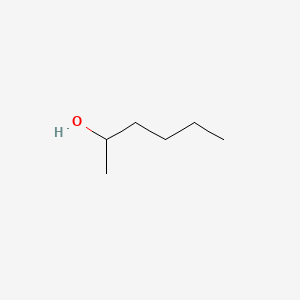| MeSH term | MeSH ID | Detail |
|---|---|---|
| Body Weight | D001835 | 333 associated lipids |
| Occupational Diseases | D009784 | 42 associated lipids |
| Peripheral Nervous System Diseases | D010523 | 33 associated lipids |
| Retrograde Degeneration | D012183 | 4 associated lipids |
2-hexanol
2-hexanol is a lipid of Fatty Acyls (FA) class. 2-hexanol often locates in Clone. The associated genes with 2-hexanol are PDC gene. The related lipids are 2-hexanol and 1-Octanol.
Cross Reference
Introduction
To understand associated biological information of 2-hexanol, we collected biological information of abnormalities, associated pathways, cellular/molecular locations, biological functions, related genes/proteins, lipids and common seen animal/experimental models with organized paragraphs from literatures.
What diseases are associated with 2-hexanol?
There are no associated biomedical information in the current reference collection.
Possible diseases from mapped MeSH terms on references
We collected disease MeSH terms mapped to the references associated with 2-hexanol
PubChem Associated disorders and diseases
What pathways are associated with 2-hexanol
There are no associated biomedical information in the current reference collection.
PubChem Biomolecular Interactions and Pathways
Link to PubChem Biomolecular Interactions and PathwaysWhat cellular locations are associated with 2-hexanol?
Visualization in cellular structure
Associated locations are in red color. Not associated locations are in black.
Related references are published most in these journals:
| Location | Cross reference | Weighted score | Related literatures |
|---|
What functions are associated with 2-hexanol?
There are no associated biomedical information in the current reference collection.
What lipids are associated with 2-hexanol?
Related references are published most in these journals:
| Lipid concept | Cross reference | Weighted score | Related literatures |
|---|
What genes are associated with 2-hexanol?
Related references are published most in these journals:
| Gene | Cross reference | Weighted score | Related literatures |
|---|
What common seen animal models are associated with 2-hexanol?
There are no associated biomedical information in the current reference collection.
NCBI Entrez Crosslinks
All references with 2-hexanol
Download all related citations| Authors | Title | Published | Journal | PubMed Link |
|---|---|---|---|---|
| Yadav GD and Pawar SV | Synergism between microwave irradiation and enzyme catalysis in transesterification of ethyl-3-phenylpropanoate with n-butanol. | 2012 | Bioresour. Technol. | pmid:22305539 |
| Prokofjevs A et al. | Borenium ion catalyzed hydroboration of alkenes with N-heterocyclic carbene-boranes. | 2012 | J. Am. Chem. Soc. | pmid:22713106 |
| OromÃ-Farrús M et al. | Acylation of Chiral Alcohols: A Simple Procedure for Chiral GC Analysis. | 2012 | J Anal Methods Chem | pmid:22649749 |
| Wang G et al. | Two new phenylpropanoids and one propanoate from Morinda citrifolia. | 2011 | J Asian Nat Prod Res | pmid:21409685 |
| Mitra S and Chopra P | Chirality and anaesthetic drugs: A review and an update. | 2011 | Indian J Anaesth | pmid:22223897 |
| Peter S et al. | Selective hydroxylation of alkanes by an extracellular fungal peroxygenase. | 2011 | FEBS J. | pmid:21812933 |
| Mota T and Giurfa M | Multiple reversal olfactory learning in honeybees. | 2010 | Front Behav Neurosci | pmid:20700501 |
| Dupuy F et al. | Calcium imaging in the ant Camponotus fellah reveals a conserved odour-similarity space in insects and mammals. | 2010 | BMC Neurosci | pmid:20187931 |
| Tsai HJ and Chou SY | A novel hydroxyfuroic acid compound as an insulin receptor activator. Structure and activity relationship of a prenylindole moiety to insulin receptor activation. | 2009 | J. Biomed. Sci. | pmid:19642985 |
| Perisse E et al. | Early calcium increase triggers the formation of olfactory long-term memory in honeybees. | 2009 | BMC Biol. | pmid:19531205 |
| Hegazi AG and Abd El-Hady FK | Influence of Honey on the Suppression of Human Low Density Lipoprotein (LDL) Peroxidation (In vitro). | 2009 | Evid Based Complement Alternat Med | pmid:18955249 |
| Pscheidt B and Glieder A | Yeast cell factories for fine chemical and API production. | 2008 | Microb. Cell Fact. | pmid:18684335 |
| Kahle KA and Foley JP | Two-chiral-component microemulsion electrokinetic chromatography-chiral surfactant and chiral oil: part 1. dibutyl tartrate. | 2007 | Electrophoresis | pmid:17464962 |
| Onaca C et al. | Degradation of alkyl methyl ketones by Pseudomonas veronii MEK700. | 2007 | J. Bacteriol. | pmid:17351032 |
| Kahle KA and Foley JP | Chiral microemulsion electrokinetic chromatography with two chiral components: Improved separations via synergies between a chiral surfactant and a chiral cosurfactant. | 2006 | Electrophoresis | pmid:16470633 |
| Won A et al. | Chirality in anesthesia I: minimum alveolar concentration of secondary alcohol enantiomers. | 2006 | Anesth. Analg. | pmid:16790631 |
| Cui P et al. | Synthesis and biological evaluation of lisofylline (LSF) analogs as a potential treatment for Type 1 diabetes. | 2006 | Bioorg. Med. Chem. Lett. | pmid:16650991 |
| Guerrieri F et al. | Perceptual and neural olfactory similarity in honeybees. | 2005 | PLoS Biol. | pmid:15736975 |
| Zheng ZX et al. | Separation of enantiomers in microemulsion electrokinetic chromatography using chiral alcohols as cosurfactants. | 2004 | Electrophoresis | pmid:15472957 |
| Gomi K et al. | Epoxide hydrolase: a mRNA induced by the fungal pathogen Alternaria alternata on rough lemon (Citrus jambhiri Lush). | 2003 | Plant Mol. Biol. | pmid:14756316 |
